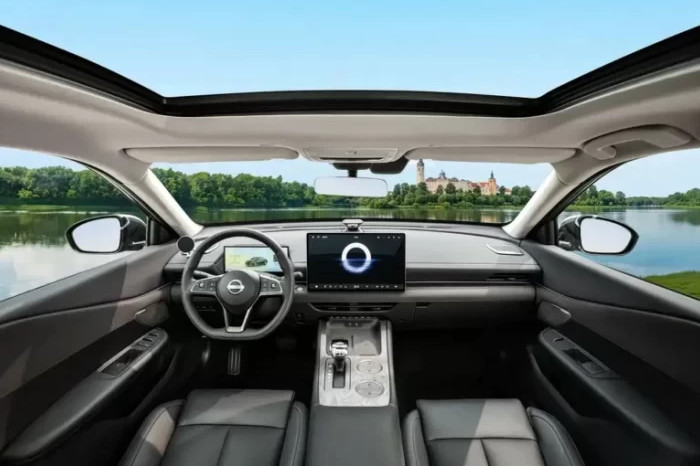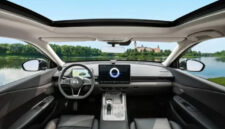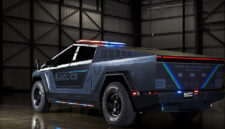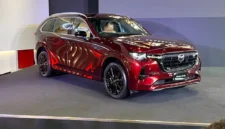BUSINESSWORTH.US – In a landmark collaboration that redefines the integration of smart technology into conventional automobiles, Dongfeng Nissan has officially unveiled the interior of the Teana HarmonyOS Cockpit. This groundbreaking release positions the Teana as the world’s first gasoline-powered vehicle to fully incorporate Huawei’s advanced HarmonyOS Cockpit System. This launch signifies a monumental leap, demonstrating that cutting-edge Chinese-developed smart technology is not exclusive to Electric Vehicles (EVs) but can seamlessly enhance the experience of Internal Combustion Engine (ICE) vehicles, bridging the gap between traditional motoring and the intelligent era.
Redefining the Interior: Luxury Meets Digital Intelligence
The new Teana HarmonyOS Cockpit immediately captivates with an interior that exudes luxury and modern sophistication, drawing clear inspiration from the minimalist, high-tech design language often seen in premium new-generation EVs. Nissan’s commitment to refinement is evident, with nearly 90% of the interior surface area draped in soft-touch materials, significantly amplifying the premium sensory experience for both the driver and passengers.
The Heart of the System: Huawei’s HarmonySpace 5
At the core of this transformation is the integration of the powerful Huawei HarmonySpace 5 Cockpit System. This system is not merely an upgrade; it is a fundamental shift in the vehicle’s digital ecosystem. The intelligent cockpit is paired with an immersive Huawei Sound System featuring 17 high-fidelity speakers, creating a concert-hall-like acoustic experience within the cabin.
The driver interface is spearheaded by a sleek 10.25-inch digital instrument panel working in conjunction with a large, central 15.6-inch intelligent touchscreen display, both powered by the HarmonySpace 5 operating system. This massive central screen serves as the nexus for all in-car functions, from navigation and media to vehicle settings.
Key Features of the HarmonyOS Cockpit:
- Millisecond-Response AI Voice Assistant: The system boasts an AI-powered voice assistant capable of providing near-instantaneous, millisecond-level responses. This rapid processing dramatically enhances the usability and safety of voice commands, making it a true conversational assistant rather than a sluggish interface.
- AI-Powered Voice Navigation: The integration includes sophisticated AI-driven voice navigation, offering more intuitive route planning and real-time traffic adjustments.
- Seamless Smartphone Integration: One of the system’s most compelling features is its deep, full integration with the user’s smartphone (particularly Huawei devices), facilitating a continuous, fluid digital experience between the car and the personal device. This capability extends to features like one-click application transfer and synchronized data across platforms.
Intriguingly, Dongfeng Nissan has opted for a balanced approach, retaining physical buttons for essential controls such as the air conditioning and volume located beneath the main screen. This decision acknowledges consumer preference for tactile feedback in critical functions, ensuring ease of use and safety while driving.
The significance of the Teana HarmonyOS Cockpit transcends just the luxury of its interior. It marks a critical moment for the broader automotive industry. For years, the most advanced smart cockpits and connectivity solutions have been primarily showcased in high-end EVs (Battery Electric Vehicles). The partnership between Nissan and Huawei effectively democratizes this advanced technology, making it accessible within a globally popular ICE sedan.
SEO Keywords Target:
- Nissan Teana HarmonyOS Cockpit: The specific product and innovation.
- Huawei HarmonyOS in Cars: The core technology and its automotive application.
- Smart Cockpit Technology: The technical category of the innovation.
- Gasoline Car Smart System: Highlighting the novelty in ICE vehicles.
- Dongfeng Nissan Collaboration: The partnership entity.
- Automotive AI Integration: The underlying technology enabler.
This integration strengthens the argument for a “Technology Transfer” strategy, where innovations born out of the highly competitive Chinese EV technology landscape are now enhancing traditional vehicles. This ensures that ICE cars remain relevant and technologically competitive against the rising wave of digital-first EVs.
Exterior Evolution: Classic Design with a Modern Blackout
While the interior represents a technological overhaul, the exterior of the Teana HarmonyOS Cockpit showcases a refined evolution, staying true to Nissan’s distinctive design heritage while embracing modern trends.
Design Language and Lighting Excellence
The exterior maintains the classic Nissan V-Motion design language, but it is now executed with an elegant, all-black finish that conveys a sportier and more assertive presence.
The front fascia is dominated by the newly designed “Cosmic Twin Star” LED headlamps. These lights are seamlessly integrated with a textured black grille, featuring a pattern of long and short feather-like stripes. This advanced lighting system is not merely aesthetic; it offers an impressive illumination range of up to 230 meters, significantly enhancing nocturnal safety and visibility.
The redesigned, more aerodynamic front bumper contributes to both the visual appeal and functional performance by effectively reducing wind noise at higher speeds.
Dimensions and Wheel Design
The side profile retains the model’s original sleek form, characterized by an optimal length-to-wheelbase ratio of approximately 0.618. The sedan sits on striking 19-inch “Diamond Cut Light Blade” alloy wheels, which contribute to its dynamic stance.
The overall dimensions underscore its status as a comfortable mid-to-large-sized sedan:
- Length:
- Width:
- Height:
- Wheelbase:
The rear design features a captivating through-type LED light assembly, which highlights an illuminated NISSAN logo centered on the trunk lid. This is accented by 11 jewel-shaped LED units on each side, adding a distinctive, premium light signature.
The vehicle is offered in several exterior colors, including a sophisticated Matte Grey and a vibrant Phantom Purple, catering to diverse consumer tastes.
Powertrain and Engineering Brilliance
Underneath the hood, the Teana HarmonyOS Cockpit maintains its commitment to high performance and efficiency through its proven powertrain technology.
The VC-Turbo Engine
The sedan continues to utilize the renowned 2.0T VC-Turbo engine unit. This engineering marvel delivers a robust output of 243 horsepower (179 kW) and a peak torque of 371 Nm. The power is managed by a Continuously Variable Transmission (CVT) that is engineered to simulate the feel and response of an 8-speed automatic transmission.
The brilliance of the VC-Turbo technology lies in its ability to intelligently alter the engine’s compression ratio on the fly. This mechanical intelligence allows the engine to switch between performance-focused lower compression ratios and efficiency-focused higher compression ratios, thereby ensuring an optimal balance between exhilarating power delivery and impressive fuel economy—a feature highly valued in the ICE market.
The Wider Context: Huawei’s Automotive Ambition
The collaboration with Dongfeng Nissan is a testament to the ambitious automotive strategy of Huawei. Having faced sanctions and restrictions in its core telecommunications business, the Chinese tech giant has aggressively pivoted into the automotive sector, positioning itself as a top-tier supplier of smart vehicle solutions.
Huawei’s strategy is multi-faceted, encompassing:
- Smart Cockpit Systems (HarmonyOS): Focusing on the in-car digital experience.
- Autonomous Driving Solutions: Developing advanced driver assistance systems (ADAS) and full self-driving technology.
- Electric Vehicle Platforms: Partnering with automakers to build complete EV platforms (e.g., AITO and Avatr).
The success of the Teana HarmonyOS Cockpit serves as a powerful case study, demonstrating Huawei’s capability to integrate its technology into established, global manufacturing platforms like Nissan. It validates the commercial viability of HarmonyOS beyond the nascent Chinese EV market and into the global, mass-market ICE segment. This penetration offers a massive potential market and establishes a strong competitive alternative to existing systems like Google’s Android Automotive and Apple’s CarPlay.
With the seamless integration of the HarmonyOS system, the Teana transcends its previous identity as a standard gasoline sedan. It now stands as a crucial bridge between the conventional vehicle world and the burgeoning intelligent era dominated by electric vehicles.
This pioneering move by Dongfeng Nissan and Huawei proves unequivocally that cutting-edge AI and advanced infotainment systems can not only coexist but thrive harmoniously within the traditional world of the Internal Combustion Engine. By making the digital experience the centerpiece, the Teana HarmonyOS Cockpit is setting a new benchmark for what consumers can expect from a modern vehicle, regardless of its underlying power source. This strategy ensures that the ICE vehicle segment is not left behind in the race for technological advancement, securing its relevance in the near-term future. The market awaits to see if this harmonious fusion will inspire other global manufacturers to similarly embrace Chinese smart technology to revitalize their conventional lineups.
The Teana HarmonyOS Cockpit is a declaration: The future of mobility is intelligent, and that intelligence is already here, available in a gasoline sedan today.












